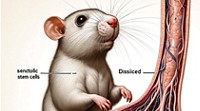Advertisement
Grab your lab coat. Let's get started
Welcome!
Welcome!
Create an account below to get 6 C&EN articles per month, receive newsletters and more - all free.
It seems this is your first time logging in online. Please enter the following information to continue.
As an ACS member you automatically get access to this site. All we need is few more details to create your reading experience.
Not you? Sign in with a different account.
Not you? Sign in with a different account.
ERROR 1
ERROR 1
ERROR 2
ERROR 2
ERROR 2
ERROR 2
ERROR 2
Password and Confirm password must match.
If you have an ACS member number, please enter it here so we can link this account to your membership. (optional)
ERROR 2
ACS values your privacy. By submitting your information, you are gaining access to C&EN and subscribing to our weekly newsletter. We use the information you provide to make your reading experience better, and we will never sell your data to third party members.
Biological Chemistry
‘Dirty Pictures’
Although not for everyone, this documentary takes audiences into the world of a garage-based chemist who makes and takes psychoactive compounds
by Jovana J. Grbic
August 14, 2012
| A version of this story appeared in
Volume 90, Issue 34

Alexander Shulgin, the subject of the documentary “Dirty Pictures,” is, depending on whom you ask, both a beloved and a reviled figure in chemistry circles. Shulgin is most famous for the popularization of 3,4-methylenedioxymethamphetamine (MDMA)—better known as the drug ecstasy. In the mid-1980s, MDMA was synthesized in a University of California, San Francisco, laboratory with the assistance of Shulgin for the purpose of administering the drug to psychiatric patients of George R. Greer, a psychiatrist affiliated with UCSF. Since the ’70s, Shulgin has synthesized and bioassayed (often personally) more than 230 psychoactive compounds, leading some to call him the “Godfather of Psychedelics.”
A Harvard-educated organic chemist once employed by Dow Chemical, Shulgin’s legitimacy in technique is irrefutable. But he left the mainstream to set up his own laboratory in the mid-’70s—with the knowledge and cooperation of the Drug Enforcement Administration (DEA)—to synthesize compounds, often providing samples to authorities. Though many sides have tried to frame Shulgin’s position, he is neither an advocate of drug use nor an opponent. He thinks of himself as a chemist first.
You can imagine that a movie exploring such a complex personality would be as unconventional as its focus, and “Dirty Pictures” indeed transcends telling a story, even by documentary standards. It doesn’t really follow a linear plot or utilize extraordinary camera technique. It is a cross section of the life and accomplishments of a notable American scientist and his devoted wife.
Most of the film’s action is direct observation of Shulgin working in his dilapidated, though fully equipped, garage lab. Ever the epitome of the “mad scientist,” Shulgin proclaims, “A real productive laboratory is a personal mess.” (Take note, film and television producers.) The film’s title, incidentally, comes from the nickname that Shulgin gave to his hand-drawn chemical structures labeling the many synthetic samples that have collected on his laboratory shelves over the years.
What the film lacks in traditional structure or production values, it certainly makes up for with protagonists, antagonists, and a colorful cast of supporting characters, including chemistry itself. Shulgin and his wife, Ann, are unquestionably the stars and unorthodox heroes of this documentary. Their shining personalities and commitment to amassing and studying psychedelic compounds will certainly give people a different angle than what they might be expecting. Ted, their son, is oddly enough straightlaced and wants nothing to do with his parents’ drug activities. He seems almost embarrassed by their hippie high jinks.
The Shulgins’ counterpoint is personified by ex-DEA agent Bob Sager, a beacon of principle and conviction in the crumbling drug war even as he emotionally admits that efforts in the war may have been in vain. Finally, a collection of research scientists (David Nichols, William Fantegrossi, John E. Mendelson, and others) rounds out the characters and attempts to provide insight into the scope of Shulgin’s body of work and what it means to each of them personally.
Director: Étienne Sauret
Editing credits: Rachel Warden
Principal Cast:
Alexander Shulgin
Ann Shulgin David Nichols
William Fantegrossi
John E. Mendelson
Ted Shulgin
Bob Sager
Topic: Science documentary
“Dirty Pictures” is in essence a film about layered juxtapositions in ideology. Alexander and Ann Shulgin, though both committed adherents of the psychedelic experience, seem to have differing viewpoints on its value. Alexander expounds on the deep meaning of mind enhancement, a way to probe the pharmacopoeia of our very existence and certainly an experimental data point for what new compound he’ll synthesize. Ann views the drugs from a romantic life-altering perspective, even writing a book about the couple’s hallucinogenic experiences. Nevertheless, the couple is clearly on the reverse side of societal norms when it comes to drugs, so seeing their fascination portrayed in a protagonistic way, rather than marginalized, is indeed engrossing.
They also stand in contrast with DEA, with whom they’ve played a decades-long cat-and-mouse game. That hasn’t stopped Shulgin from developing a quirky friendship with Sager. The film even highlights the internal disagreements within the scientific community about Shulgin’s value to science. Some of the chemists and doctors interviewed think that he is a chemistry genius along with the likes of Chemistry Nobel Laureates Emil Fischer and E. J. Corey and that he’s been unfairly ostracized. They believe his tremendous body of work is for the betterment of neurological treatments. Yet others vociferously contend that Shulgin has made a mockery of a proud, skilled discipline while simultaneously providing a road map for drug abuse.
“Dirty Pictures” is at its best when it’s in motion: observing Shulgin at work in his garage laboratory, recording the reactions the Shulgins get when they’re at public events (yes, even Burning Man!), and interviewing their cohorts and detractors to give a view into their thoughts and life. The film weakens during stretches when viewers simply watch Alexander and Ann in their home, going about daily tasks.
Ultimately, “Dirty Pictures” is a film one can easily compare to a psychedelic experience in and of itself—a highly personal matter of taste that some will swear by, others will hate, and still others will indifferently “not get.” Like it, love it, or hate it, “Dirty Pictures,” a glorious love letter to the extreme reaches of synthetic chemistry, will still leave viewers talking long after they’ve see it.
Jovana J. Grbić, Ph.D., is the creative director of Los Angeles-based ScriptPhD, specializing in science communication in entertainment, advertising, and media, and tweets as @ScriptPhD.




Join the conversation
Contact the reporter
Submit a Letter to the Editor for publication
Engage with us on Twitter